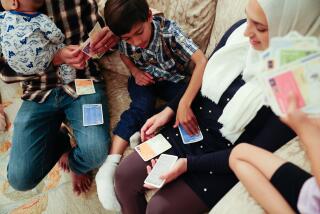Ancestors’ Yule Traditions Preserved
- Share via
Our immigrant ancestors brought with them festive holiday recipes and their religious customs from the old countries, and through the years our families have commingled and preserved many of them.
Hollanders transported St. Nicholas and his gift-giving tradition to America in the 17th Century. The Dutch claimed St. Nicholas rode through the air on a great white horse that could jump from roof to roof. They told their wide-eyed toddlers how St. Nicholas slipped down the chimney to cram gifts in the wooden shoes of good little children.
Germans knew about St. Nicholas, too, but believed him to be an advance messenger looking into children’s behavior. On Christmas Day, it was the Weihnachtsmann (Christmas man) or Christ Kindle (Christ Child) himself who brought blessings and presents for everyone.
Roast goose, pfefferkuchen (pepper cake/cookies) and long loaves of bread full of nuts, raisins, citron and dried fruits --called Christstollen--are some holiday foods our German ancestors served.
The Weihnachtsbaum, or Christmas tree, is the symbol of the German yuletide, and this custom also came with our families when they immigrated to this country.
Jewish families celebrate the eight days of Hanukkah that commemorates the rededication of the temple of Jerusalem. They light candles in synagogues and their homes, play games and exchange gifts during this festive period, which usually occurs in December.
Potato pancakes are served during Hanukkah by many families with Ashkenazic ancestry, while those who descend from Sephardic lines often enjoy sweet pastries fried in oil.
Many of our families came from Great Britain and naturally brought with them their holiday traditions and special food, such as rich plum puddings, mince pies and the wassail bowl. The wassail bowl--a mixture of hot ale, or wine, with sugar, roasted apples and spices--is prepared for friends and family who are toasted with:
“Love and joy come to you, and to your wassail--too.”
Our Norwegian ancestors contributed lutefish and fladbrod (a hard, flat bread) to our Christmastime menus as well as baked delicacies such as gingerbreads, coffee breads and animal cookies for the tree.
In Norway, Jul, the season of peace on Earth and good will toward all God’s creatures, was celebrated by placing sheaves of wheat in the yards or on top of houses to furnish holiday cheer for the birds, and farm animals were given extra feedings.
Bunuelos--thin pancakes served with a brown sugar sauce--are often featured at Christmas Eves feasts in homes with Latino heritage. A tradition imported from Mexico is the pinata. This pottery container, covered with paper, is filled with sweets and toys. It is then hung by a long rope from the ceiling. One by one the children are blindfolded, spun around and allowed to strike the pinata with a stick to spill the goodies.
Danish families traditionally eat roast goose stuffed with prunes and apples, red cabbage, and grod, a rice pudding containing sugar, cinnamon and an almond. The finder of the almond in the grod is rewarded with a gift.
In 1844, Clement Moore’s “ ‘Twas the Night Before Christmas” was published. It identified St. Nicholas to us as St. Nick, the little old driver, so lively and quick. However, it was Thomas Nast, the German-American cartoonist, who created the first published (1863-64) Santa Claus picture in “A Visit From St. Nicholas.”
Most of our holiday recipes have roots in the various lands of our ancestors. For an all-American feast, choose roast turkey, cranberry sauce and pumpkin pie.
Get your family to stay up late with you on Christmas Eve and see if you can identify Santa’s reindeer as they land on your rooftop. They have such interesting old American names--Dasher, Dancer, Prancer, Vixen, Comet, Cupid, Donner and Blitzen.
For a beginner’s how-to genealogy kit (with charts) send $4, and address your questions (please include a self-addressed, stamped envelope) to Myra Vanderpool Gormley, Box 64316, Tacoma, Wash. 98464.
More to Read
Eat your way across L.A.
Get our weekly Tasting Notes newsletter for reviews, news and more.
You may occasionally receive promotional content from the Los Angeles Times.










